March 12 - 19, 2006
In the morning we headed north to visit the town of Napier. Napier was completely destroyed by an earthquake in 1931 and rebuilt in art deco style. The buildings have been well kept up over the years and it was a delight to walk around and ooh and ahh at the lovely colors and styles.
|
Leaving Napier after lunch, we were fortunate to find a carwash to get the truck washed. It was one of those do-it-yourself washes with the brushes, sprayers, etc. For $12.00NZ we were able to really scrub the Fuso down.
We continued north toward Lake Taupo which we had visited on our way south. We discussed the camping options along the way and decided to check out a free site we had seen while driving around town. On our way to that site, we chanced upon an official free camping site right along the Waikato River, just above Huka Falls. It was a large site with camping spaces along the river and across the driving path on grass. The site was already quite full with other campers, but we managed to find a site right alongside the river.
With the falls just a little ways downstream, the flow of water going by was tremendous. The river narrows from 100 meters wide to 15 meters with 220,000 liters/second flowing by. We sat and enjoyed the river with an eddy right in front of us that attracted ducks. We also watched some people come downstream in inner tubes and get out at the campground. We then noticed that the people camped next to us also had inner tubes. We went to speak to them about floating the river and found out that it is pretty easy to do and we decided to do it the next day. We sat around for a while longer until we were chased inside when it started raining. This was the first rain we had seen in quite a while, but it wasn't surprising, we had just gotten the truck washed!
In the morning it was still raining. We waited around for a little while to see if it would stop and when it didn't, we hit the road. Disappointed that we weren't able to float down the river (doing it in the rain didn't sound like fun) we headed north. Along the way we decided to visit Waikite Thermal Pools, one of the many hot springs and found a good deal where we could camp and have unlimited use of the hot springs, all for one price. They also had a washer and dryer and the price was the best we've seen on the trip. So we put a load of laundry in and headed for the hot springs. We alternated between soaking and washing and drying and it was a very relaxing afternoon. We finished our laundry and our soaking just in time for another tremendous rain storm to hit. Once again we were grateful for our nice, dry Fuso.
The next morning we stopped off in the town of Rotorua to visit the Anglican Church and the Marae that sit side by side. Both buildings are decorated in the Maori style with lots of carvings. The church has a very interesting clear, etched window, that overlooks Lake Rotorua. When one is seated in the pew directly in front of it, it appears that Jesus, dressed in Maori robes, is walking on the water. Sorry no photos were allowed to be taken inside and we respect that. Both buildings are located on waterfront land owned by the Maori and there are several other Maori sacred spots in the same location, but once again we had to run between the raindrops to visit them.
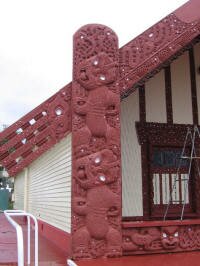
|
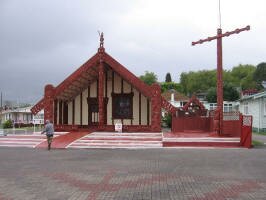
|
Rotorua is a huge draw for tourists because there is so much to do there, but it is all expensive. Even all of the outdoor experiences are on private land and everything costs money to access so we decided to continue up the coast to explore the Coromandel Peninsula. Along the way we stopped at a bird sanctuary at Opoutere. This area is a nesting spot for the endangered New Zealand Dotterel. Because it was high tide, we had to take a longer hike through the hills to get out to where the birds were nesting. It was still raining on and off but when we finally arrived at the beach, we did get to see several of the birds running along the sand dunes. The area is roped off to protect the bird nests which are just shallow holes scratched into the sand. It would be very easy for unsuspecting humans to step on them.
Because the peninsula is so close to Auckland, the areas to camp are greatly restricted. We tried to camp at a campground near the bird sanctuary but ran into some difficulties, not the least of which was the automatic arm that attempted to drop down onto the Fuso when we tried to get through the gate. So we decided to look for another spot. We continued up the coast through increasing wind and rain and found lots of no-parking signs. We finally chanced upon the Pohutukawa Recreational Reserve. While the reserve itself did not allow camping, we followed the road until it ended and found a flat, quiet spot that was also out of the wind to spend the night. After a long day of driving in wind and rain, this was a little piece of heaven.
In the morning, the sun was finally shining and we drove back to the reserve to have breakfast. But first we decided to hike along the beach. The views were spectacular and everything was clean and bright after the rain. We even saw another New Zealand Kingfisher flashing his turquoise wings. Returning to the truck we set up our chairs and table on one of the platforms often found in New Zealand parks and enjoyed the sun and the view along with our breakfast.
As the tide was on its way out, we decided to stop at Hot Water Beach on our way north. This is a famous local beach where at low tide, hot water bubbles up through the sand and you can dig a hole and sit in the hot water. Except not today. And apparently not for a few days preceding either. Apparently rough seas had been preventing the tide from receding as far as it needed to, to access the springs, so lots and lots of tourists were digging fruitlessly in the wet sand trying to find some hot water. The best we could find was if you wiggled your toes and scrunched your feet down into the wet sand, it might feel a little warm, but that was it. So we contented ourselves with watching all the other tourists fight against the tide and dig, bail and dig, bail and dig...
|
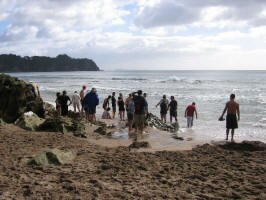
|
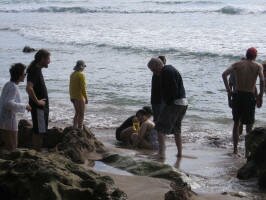
|
We continued up and across the peninsula, with gorgeous coastal scenery alternating with inland farms. We crossed over a ridge and stopped at a viewpoint where you can see both sides of the peninsula at once. It was quite impressive.

We went down the other side and passed through the quaint town of Coromandel. Continuing on we picked Colville Farm as our camping spot for the night. And what a fine choice it was. For only $10NZ, we were given the run of the farm and we could camp anywhere we wanted to on their 1,260 hectares/2,772 acres. So we chose a grassy spot next to a creek to set up camp and pulled out the BBQ to roast up some great NZ lamb.
| The next morning we rose early so that we could help gather the eggs, feed the pigs and milk the cow. For some reason I've always wanted to milk a cow and this was my opportunity. It wasn't difficult and the cow was warm and agreeable. When we were done, we returned to the Fuso with the freshest eggs and milk we've ever had. We were also invited to pick apples and peaches off the trees which were absolutely delicious. After breakfast we were given directions up the beach to dig for pipis which are a type of clam. We found a whole bunch and took some back for our kind hosts at Colville Farm. We then continued on our way, stopping at an ocean overlook to cook and enjoy our pipis. |
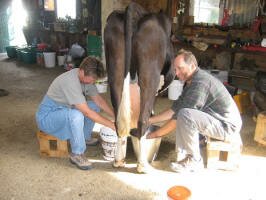
|
We continued down the west coast of the peninsula trying to enjoy the gorgeous scenery while trying not to run into anyone head-on on the extremely narrow, sometimes only one lane, road. One lane wouldn't be so bad if the road were straight, but the curves made it really difficult to see if anyone was coming. Kinda scary.
| We finally made it around the bottom of the peninsula and headed west to the Miranda Shorebird Center on the Firth of Thames. This area is one of the world's greatest migratory bird habitats and during the summer over 40,000 birds arrive. They migrate all the way from the Arctic just to come and eat. We could see the reason on the ground was literally paved with shells. |
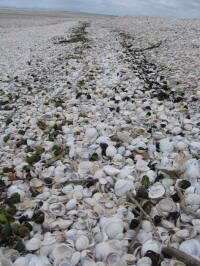
|
We took a hike through the marshy area and we could see thousands of shorebirds assembled along the shore. Fortunately the tide was in so the birds were close to the viewing areas and we could identify some of the different types of birds. We saw Bar-tail Godwits, South Island Pied Oystercatchers, Pied Stilts, Red Knots, Caspian Terns, several species of gulls and the adorable Wrybill Plover with his sideways curving beak (the only bird in the world to have a sideways curve). We also saw one white heron. Our timing was wonderful when we were there because the tide was high, the sun was behind us and at one point there was a huge full rainbow with flocks of birds in front of it. Beautiful. |
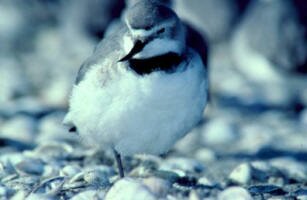
The Wrybill Plover
(Courtesy of the Miranda Shorebird Centre)
|
Tearing ourselves away, we continued up the coast to another free coastal campsite, this one named Ray's Rest. As we approached we could see RVs lined along the beach, but as we got closer we could see that they were really spread apart. As it was a Friday night, we expected a lot more vehicles to show up, but the stretch of beach was so long that no one really got close to anyone else. Before it got dark, we took a stroll along the beach and watched two fisherman wading chest deep in the water with a net strung vertically between two poles. They waded out and then walked perpendicular to the beach for quite a ways before coming back to shore to harvest the flounder they had collected in the net. It was very interesting to watch.
The next morning we decided to spend the day and started working on odds and ends that would need to be done before we could store the Fuso. In the afternoon we noticed that quite a few more RVs had arrived so we took a walk to explore. While we were walking, we noticed more people fishing, some of them very creatively. Some just took their nets out with their boats and left them until the next day, but one fellow had rigged up a system by which he used a kite (we're not kidding) to pull his net out into the water and hold it there. After a couple of hours, he hauled the kite/net in and collected his catch. The people who were camped next to us just used their boat to drop their net with floats.
In the evening these neighbors invited us to join them for a drink along with the neighbors on the other side of them. Once again, we spent a very enjoyable evening learning about New Zealand, each other and the art of flounder fishing. In the morning these same new friends presented us with 4 of the flounder they caught in their net overnight.
Too soon it was time to head toward Auckland and the end of this trip. Along the way we picked up a rental car to get us back to the airport and then headed towards the town of Mangawhai where new friends live who offered to let us store the Fuso on their property. Arriving in the afternoon, we enjoyed an evening with Shona and Murray and their adorable puppy Deefer ("D-for-dog"). The next day was spent cleaning and sorting and packing and covering. It's always more work than we think it's going to be! But once again we were able to spend a delightful evening with our hosts who are the epitome of hospitality. It was sad to say goodbye to all our new friends and the country itself, but we'll be back in a couple of months to reconnect.

|